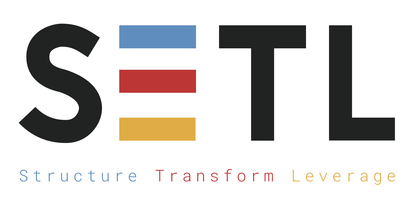If you’re a data scientist or data engineer, this might sound familiar while working on an ETL project:
- Switching between multiple projects is a hassle
- Debugging others’ code is a nightmare
- Spending a lot of time solving non-business-related issues
SETL (Spark ETL, pronounced "settle") is a Scala framework that helps you structure your Spark ETL projects, modularize your data transformation logic and speed up your development.
You can start working by cloning this template project.
<dependency>
<groupId>com.jcdecaux.setl</groupId>
<artifactId>setl_2.11</artifactId>
<version>0.4.0</version>
</dependency>To use the SNAPSHOT version, add Sonatype snapshot repository to your pom.xml
<repositories>
<repository>
<id>ossrh-snapshots</id>
<url>https://oss.sonatype.org/content/repositories/snapshots/</url>
</repository>
</repositories>
<dependencies>
<dependency>
<groupId>com.jcdecaux.setl</groupId>
<artifactId>setl_2.11</artifactId>
<version>0.4.1-SNAPSHOT</version>
</dependency>
</dependencies>With SETL, an ETL application could be represented by a Pipeline. A Pipeline contains multiple Stages. In each stage, we could find one or several Factories.
The class Factory[T] is an abstraction of a data transformation that will produce an object of type T. It has 4 methods (read, process, write and get) that should be implemented by the developer.
The class SparkRepository[T] is a data access layer abstraction. It could be used to read/write a Dataset[T] from/to a datastore. It should be defined in a configuration file. You can have as many SparkRepositories as you want.
The entry point of a SETL project is the object com.jcdecaux.setl.Setl, which will handle the pipeline and spark repository instantiation.
You can find the following tutorial code in the starter template of SETL. Go and clone it :)
Here we show a simple example of creating and saving a Dataset[TestObject]. The case class TestObject is defined as follows:
case class TestObject(partition1: Int, partition2: String, clustering1: String, value: Long)Suppose that we want to save our output into src/main/resources/test_csv. We can create a configuration file local.conf in src/main/resources with the following content that defines the target datastore to save our dataset:
testObjectRepository {
storage = "CSV"
path = "src/main/resources/test_csv"
inferSchema = "true"
delimiter = ";"
header = "true"
saveMode = "Append"
}In our App.scala file, we build Setl and register this data store:
val setl: Setl = Setl.builder()
.withDefaultConfigLoader()
.getOrCreate()
// Register a SparkRepository to context
setl.setSparkRepository[TestObject]("testObjectRepository")
We will create our Dataset[TestObject] inside a Factory[Dataset[TestObject]]. A Factory[A] will always produce an object of type A, and it contains 4 abstract methods that you need to implement:
- read
- process
- write
- get
class MyFactory() extends Factory[Dataset[TestObject]] with HasSparkSession {
import spark.implicits._
// A repository is needed for writing data. It will be delivered by the pipeline
@Delivery
private[this] val repo = SparkRepository[TestObject]
private[this] var output = spark.emptyDataset[TestObject]
override def read(): MyFactory.this.type = {
// in our demo we don't need to read any data
this
}
override def process(): MyFactory.this.type = {
output = Seq(
TestObject(1, "a", "A", 1L),
TestObject(2, "b", "B", 2L)
).toDS()
this
}
override def write(): MyFactory.this.type = {
repo.save(output) // use the repository to save the output
this
}
override def get(): Dataset[TestObject] = output
}To execute the factory, we should add it into a pipeline.
When we call setl.newPipeline(), Setl will instantiate a new Pipeline and configure all the registered repositories as inputs of the pipeline. Then we can call addStage to add our factory into the pipeline.
val pipeline = setl
.newPipeline()
.addStage[MyFactory]()pipeline.describe().run()The dataset will be saved into src/main/resources/test_csv
As our MyFactory produces a Dataset[TestObject], it can be used by other factories of the same pipeline.
class AnotherFactory extends Factory[String] with HasSparkSession {
import spark.implicits._
@Delivery
private[this] val outputOfMyFactory = spark.emptyDataset[TestObject]
override def read(): AnotherFactory.this.type = this
override def process(): AnotherFactory.this.type = this
override def write(): AnotherFactory.this.type = {
outputOfMyFactory.show()
this
}
override def get(): String = "output"
}Add this factory into the pipeline:
pipeline.addStage[AnotherFactory]()You can generate a Mermaid diagram by doing:
pipeline.showDiagram()You will have some log like this:
--------- MERMAID DIAGRAM ---------
classDiagram
class MyFactory {
<<Factory[Dataset[TestObject]]>>
+SparkRepository[TestObject]
}
class DatasetTestObject {
<<Dataset[TestObject]>>
>partition1: Int
>partition2: String
>clustering1: String
>value: Long
}
DatasetTestObject <|.. MyFactory : Output
class AnotherFactory {
<<Factory[String]>>
+Dataset[TestObject]
}
class StringFinal {
<<String>>
}
StringFinal <|.. AnotherFactory : Output
class SparkRepositoryTestObjectExternal {
<<SparkRepository[TestObject]>>
}
AnotherFactory <|-- DatasetTestObject : Input
MyFactory <|-- SparkRepositoryTestObjectExternal : Input
------- END OF MERMAID CODE -------
You can copy the previous code to a markdown viewer that supports Mermaid.
Or you can try the live editor: https://mermaid-js.github.io/mermaid-live-editor/#/edit/eyJjb2RlIjoiY2xhc3NEaWFncmFtXG5jbGFzcyBNeUZhY3Rvcnkge1xuICA8PEZhY3RvcnlbRGF0YXNldFtUZXN0T2JqZWN0XV0-PlxuICArU3BhcmtSZXBvc2l0b3J5W1Rlc3RPYmplY3RdXG59XG5cbmNsYXNzIERhdGFzZXRUZXN0T2JqZWN0IHtcbiAgPDxEYXRhc2V0W1Rlc3RPYmplY3RdPj5cbiAgPnBhcnRpdGlvbjE6IEludFxuICA-cGFydGl0aW9uMjogU3RyaW5nXG4gID5jbHVzdGVyaW5nMTogU3RyaW5nXG4gID52YWx1ZTogTG9uZ1xufVxuXG5EYXRhc2V0VGVzdE9iamVjdCA8fC4uIE15RmFjdG9yeSA6IE91dHB1dFxuY2xhc3MgQW5vdGhlckZhY3Rvcnkge1xuICA8PEZhY3RvcnlbU3RyaW5nXT4-XG4gICtEYXRhc2V0W1Rlc3RPYmplY3RdXG59XG5cbmNsYXNzIFN0cmluZ0ZpbmFsIHtcbiAgPDxTdHJpbmc-PlxuICBcbn1cblxuU3RyaW5nRmluYWwgPHwuLiBBbm90aGVyRmFjdG9yeSA6IE91dHB1dFxuY2xhc3MgU3BhcmtSZXBvc2l0b3J5VGVzdE9iamVjdEV4dGVybmFsIHtcbiAgPDxTcGFya1JlcG9zaXRvcnlbVGVzdE9iamVjdF0-PlxuICBcbn1cblxuQW5vdGhlckZhY3RvcnkgPHwtLSBEYXRhc2V0VGVzdE9iamVjdCA6IElucHV0XG5NeUZhY3RvcnkgPHwtLSBTcGFya1JlcG9zaXRvcnlUZXN0T2JqZWN0RXh0ZXJuYWwgOiBJbnB1dFxuIiwibWVybWFpZCI6eyJ0aGVtZSI6ImRlZmF1bHQifX0=
You can either copy the code into a Markdown viewer or just copy the link into your browser (link) 🍻
SETL currently supports the following data source:
- All file formats supported by Apache Spark (csv, json, parquet etc)
- Excel
- JDBC (you have to provide the jdbc driver)
- Cassandra
- DynamoDB
To read/write data from/to AWS S3 (or other storage services), you should include the corresponding hadoop library in your project.
For example
<dependency>
<groupId>org.apache.hadoop</groupId>
<artifactId>hadoop-aws</artifactId>
<version>2.9.2</version>
</dependency>
You should also provide Scala and Spark in your pom file. SETL is tested against the following version of Spark:
| Spark Version | Scala Version | Note |
|---|---|---|
| 2.4 | 2.11 | ✔️ Ok |
| 2.4 | 2.12 | ✔️ Ok |
| 2.3 | 2.11 |
DynamoDBConnectordoesn't work with Spark version 2.3Compressannotation can only be used on Struct field or Array of Struct field with Spark 2.3

